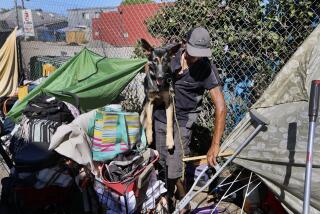First Step in Regaining Control of ‘Ghost Town’ : City takes a welcome, stronger stance at North Hills site
- Share via
A significant percentage of serious crime is adventitious, in that it follows the path of least resistance. This kind of crime is not the result of slow or inevitable urban deterioration. It moves in because control over an area has been suddenly relinquished. The criminals are not interested in the underlying reasons for the loss of legitimate municipal authority in a given geographical area. The only thing that matters to them is finding new ground in which they can ply their trade without fear of punishment or capture.
Viewing crime in that light in the late 1980s helped create the idea of community-oriented policing. It needs to be reconsidered and reapplied now in relation to the “ghost towns” that have resulted from the Northridge quake.
What is the most likely result, for example, when a neighborhood is marred by increasing amounts of graffiti and vandalism, when street lights are broken more quickly than they can be replaced, when trash and litter piles up and is not removed, and when buildings are abandoned and subsequently damaged long before they can be reoccupied?
Simple answer: one begins to feel that the criminals hold sway there, and not the municipal authorities. Neighbors and former residents rather quickly feel as though they are under siege, and the folks with bad intentions are emboldened. Community policing is actually a misnomer in that the policing is just one part of the solution. Other vital parts include the agencies that replace light bulbs, repaint buildings, clean streets and decide on what can and cannot be rebuilt.
On quake day, those parts of the city that sustained the most complete damage became as fertile a ground for crime and opportunism as any seriously deteriorated housing project or badly depressed neighborhood. Bringing those ghost towns back to life will require a similar kind of vigilance, long-term commitment and extensive cooperation among government agencies.
It won’t be enough, even in the relative short-term period of these past nine months, to fence off and board up buildings and hope for the best. A case in point is the ghost town in North Hills, just east of the San Diego Freeway, between Roscoe and Nordhoff Boulevards.
In hindsight, it seems palpably absurd that anyone thought that the city’s original response of some fencing and boarding and two unarmed security guards would be adequate to the task. This ghost town is huge, involving 41 abandoned apartment buildings. It was hardly enough to keep up with gangs, squatters, drug dealers and prostitutes.
Now, thanks to an outcry from an unusually active citizens group, and because of pressure from City Councilman Richard Alarcon, a better response has been fashioned for North Hills. There now will be 10 private security guards, some of them armed. Police deployed on horseback have also been tried, but a beefed-up two-legged presence would probably suffice. But neighbors are pleased by the stronger posture, and the City Council’s earthquake recovery committee says it will review the new steps in a month to see if matters have improved.
Still, this is only a first step toward the hard work of recovery. One can hardly hope that people will want to rebuild or take over units in the ghost towns until it is quite clear that the city, and not the crooks, are in control of them.
More to Read
Sign up for Essential California
The most important California stories and recommendations in your inbox every morning.
You may occasionally receive promotional content from the Los Angeles Times.













